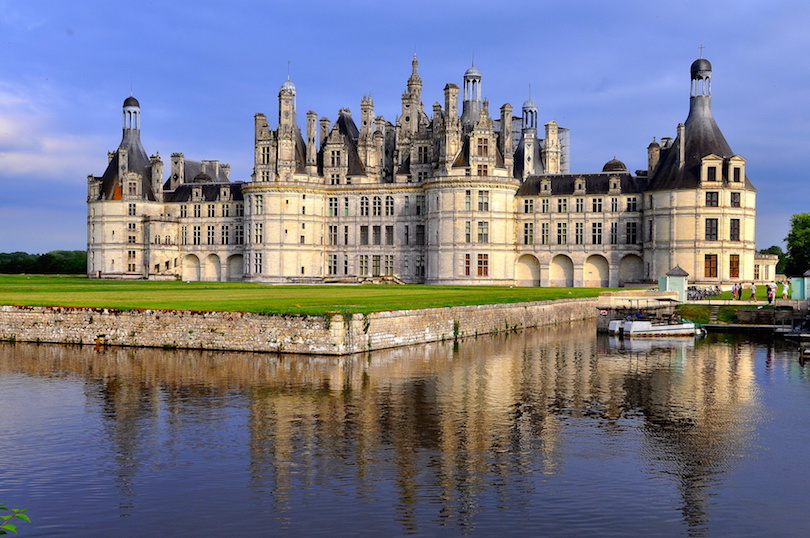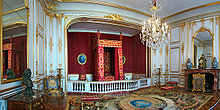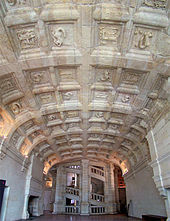
This second most visited château in France (after Versailles), is a masterpiece of the French Renaissance. Chateau de Chambord features 440 rooms, 365 fireplaces, and 84 staircases. Construction of the chateau started in 1519 by King François I so he could hunt in the nearby forests. The cold and massive rooms of the Château made it unpopular as an actual residence and François I himself stayed here for less than 40 days in total.The Château de Chambord (French pronunciation: [ʃɑto də ʃɑ̃bɔʁ]) in Chambord, Loir-et-Cher, France, is one of the most recognisable châteaux in the world because of its very distinctive French Renaissance architecture which blends traditional French medieval forms with classical Renaissance structures. The building, which was never completed, was constructed by Francis I.Chambord is the largest château in the Loire Valley; it was built to serve as a hunting lodge for Francis I, who maintained his royal residences at the Château de Blois and Amboise. The original design of the Château de Chambord is attributed, to Italian architectDomenico da Cortona; Leonardo da Vinci may also have been involved.
Chambord was altered considerably during the twenty-eight years of its construction (1519–1547), during which it was overseen on-site by Pierre Nepveu. With the château nearing completion, Francis showed off his enormous symbol of wealth and power by hosting his old archrival, Emperor Charles V, at Chambord.
In 1792, in the wake of the French Revolution, some of the furnishings were sold and timber removed. For a time the building was left abandoned, though in the 19th century some attempts were made at restoration. During the Second World War, art works from the collections of the Louvre and the Château de Compiègne were moved to the Château de Chambord. The château is now open to the public, receiving 700,000 visitors in 2007. Flooding in June 2016 damaged the grounds but not the château itself.
History
Who designed the Château de Chambord is a matter of controversy.[9] The original design is attributed, though with several doubts, to Domenico da Cortona, whose wooden model for the design survived long enough to be drawn by André Félibien in the 17th century.[10] In the drawings of the model, the main staircase of the keep is shown with two straight, parallel flights of steps separated by a passage and is located in one of the arms of the cross. According to Jean Guillaume, this Italian design was later replaced with the centrally located spiral staircase, which is similar to that at Blois, and a design more compatible with the French preference for spectacular grand staircases. However, "at the same time the result was also a triumph of the centralized layout—itself a wholly Italian element."[11] In 1913 Marcel Reymond suggested[12] that Leonardo da Vinci, a guest of Francis at Clos Lucé near Amboise, was responsible for the original design, which reflects Leonardo's plans for a château at Romorantin for the King's mother, and his interests in central planning and double-spiral staircases; the discussion has not yet concluded,[13] although most scholars now agree that Leonardo was at least responsible for the design of the central staircase.[14]Archeological findings by Jean-Sylvain Caillou & Dominic Hofbauer have established that the lack of symmetry of some facades derives from an original design, abandoned shortly after the construction began, and which ground plan was organised around the central staircase following a central gyratory symmetry.[15] Such a rotative design has no equivalent in architecture at this period of history, and appears reminiscent of Leonardo Da Vinci's works on hydraulic turbines, or the helicopter. Had it been respected, it is believed that this unique building could have featured the quadruple-spiral open staircase, strangely described by John Evelyn and Andrea Palladio although it was never built.Regardless of who designed the château, on 6 September 1519 Francis Pombriant was ordered to begin construction of the Château de Chambord.[16] The work was interrupted by the Italian War of 1521–1526, and work was slowed by dwindling royal funds[17] and difficulties in laying the structure's foundations. By 1524, the walls were barely above ground level.[16] Building resumed in September 1526, at which point 1,800 workers were employed building the château. At the time of the death of King Francis I in 1547, the work had cost 444,070 livres.[17]

Painting by Pierre-Denis Martin of Château de Chambord in 1722The château was built to act as a hunting lodge for King Francis I;[4] however, the king spent barely seven weeks there in total, that time consisting of short hunting visits. As the château had been constructed with the purpose of short stays, it was not practical to live in on a longer-term basis. The massive rooms, open windows and high ceilings meant heating was impractical. Similarly, as the château was not surrounded by a village or estate, there was no immediate source of food other than game. This meant that all food had to be brought with the group, typically numbering up to 2,000 people at a time.
As a result of all the above, the château was completely unfurnished during this period. All furniture, wall coverings, eating implements and so forth were brought specifically for each hunting trip, a major logistical exercise. It is for this reason that much furniture from the era was built to be disassembled to facilitate transportation. After Francis died of a heart attack in 1547, the château was not used for almost a century.For more than 80 years after the death of King Francis I, French kings abandoned the château, allowing it to fall into decay. Finally, in 1639 King Louis XIII gave it to his brother, Gaston d'Orléans, who saved the château from ruin by carrying out much restoration work.

Louis XIV's ceremonial bedroomKing Louis XIV had the great keep restored and furnished the royal apartments. The king then added a 1,200-horse stable, enabling him to use the château as a hunting lodge and a place to entertain a few weeks each year. Nonetheless, Louis XIV abandoned the château in 1685.[18]From 1725 to 1733, Stanislas Leszczyński(Stanislas I), the deposed King of Poland and father-in-law of King Louis XV, lived at Chambord. In 1745, as a reward for valour, the king gave the château to Maurice de Saxe, Marshal of France who installed his military regiment there.[19] Maurice de Saxe died in 1750 and once again the colossal château sat empty for many years.
French Revolution and modern historyEdit

On the second floorIn 1792, the Revolutionary government ordered the sale of the furnishings; the wall panellings were removed and even floors were taken up and sold for the value of their timber, and, according to M de la Saussaye,[20] the panelled doors were burned to keep the rooms warm during the sales; the empty château was left abandoned until Napoleon Bonaparte gave it to his subordinate, Louis Alexandre Berthier. The château was subsequently purchased from his widow for the infant Duke of Bordeaux, Henri Charles Dieudonné (1820–1883) who took the title Comte de Chambord. A brief attempt at restoration and occupation was made by his grandfather King Charles X (1824–1830) but in 1830 both were exiled. In Outre-Mer: A Pilgrimage Beyond the Sea, published in the 1830s, Henry Wadsworth Longfellowremarked on the dilapidation that had set in: "all is mournful and deserted. The grass has overgrown the pavement of the courtyard, and the rude sculpture upon the walls is broken and defaced".[21] During the Franco-Prussian War (1870–1871) the château was used as a field hospital.The final attempt to make use of the colossus came from the Comte de Chambord but after the Comte died in 1883, the château was left to his sister's heirs, the titular Dukes of Parma, then resident in Austria. First left to Robert, Duke of Parma, who died in 1907 and after him, Elias, Prince of Parma. Any attempts at restoration ended with the onset of World War I in 1914. The Château de Chambord was confiscated as enemy property in 1915, but the family of the Duke of Parma sued to recover it, and that suit was not settled until 1932; restoration work was not begun until a few years after World War II ended in 1945.[22]The Château and surrounding areas, some 5,440 hectares (13,400 acres; 21.0 sq mi), have belonged to the French state since 1930.[23]
Today, the Château de Chambord is a popular tourist attraction.In 1939, shortly before the outbreak of World War II, the art collections of the Louvre and Compiègne museums (including the Mona Lisa and Venus de Milo) were stored at the Château de Chambord. An American B-24 Liberator bomber crashed onto the château lawn on 22 June 1944.[24] The image of the château has been widely used to sell commodities from chocolate to alcohol and from porcelain to alarm clocks; combined with the various written accounts of visitors, this made Chambord one of the best known examples of France's architectural history.[25]Today, Chambord is a major tourist attraction, and in 2007 around 700,000 people visited the château.[21]After unusually heavy rainfall, Chambord was closed to the public from 1 to 6 June 2016. The river Cosson, a tributary of the Loire, flooded its banks and the chateau's moat. Drone photography documented some of the peak flooding.[26] The French Patrimony Foundation [fr] described effects of the flooding on Chambord's 13,000-acre property. The 20-mile wall around the chateau was breached at several points, metal gates were torn from their framing, and roads were damaged. Also, trees were uprooted and certain electrical and fire protection systems were put out of order. However, the chateau itself and its collections reportedly were undamaged. The foundation observed that paradoxically the natural disaster effected Francis I's vision that Chambord appear to rise from the waters as if it were diverting the Loire.[27] Repairs are expected to cost upwards of a quarter-million dollars.[28]
Comments
Post a Comment